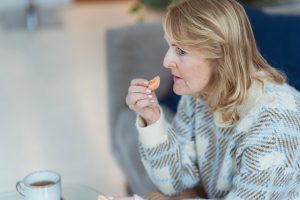6.2.2 Assessing a client’s special needs during mealtime
Food intake is a basic need for good health. A person without disease or illness who is able to care for their own needs may not be affected if they missed the nutrients of one meal, but a person who has a disease or illness or who needs to depend on others for care will be negatively impacted by the loss of nutrients from one meal.
As a personal care assistant, you will be assisting clients with their nourishment needs daily, and your observations can make a difference in how well they are able to receive nourishment.

When you assess your client’s needs for meal times consider using this checklist as a guide:
- What is their visual ability? Do they need assistance or cueing to find the utensils or to identify or locate the food?
- Are they able to hold the utensils? Do they need the utensils to be altered to use them effectively?
- Do they have the strength to pick up the food and place it in their mouth? Do you need to offer help using the hand-under-hand method to help them bring the food to their mouth?
- Do they have the cognitive ability to initiate or continue feeding themselves? Do they lose focus and need cueing to continue the eating process?
- Do they need special items to help them feed themselves, and do they have access to these special items?
- Does their plate move on the table, and can they lift the food off the plate or does it fall over the edge?
- Do they have their dentures in, if they wear them? Do the dentures rub or cause pain in the mouth?
- Are they able to chew and swallow without special diets? Are they having trouble swallowing, and do they need a special diet for a few days until their swallowing can be evaluated by a speech therapist?
- Has there been a change in their ability regarding the intake of food and fluids since they last ate?
Your answers to each of these questions will allow you to pinpoint areas where your client has an eating-related need that must be met. Use this information to implement solutions based on the policies at your facility or agency. Or, if no policy exists, consider speaking with your supervisor and other members of the interdisciplinary health care team about your ideas, or ask for them to make suggestions.
Did You Know?
The goal of the checklist above is to promote independent eating whenever possible. Independent eating is linked to many key benefits that align with the DIPPS protocol. Please use the link to review the DIPPS protocol now, if needed.
Independent eating is linked to many key benefits that align with the DIPPS protocol. First, the activity of eating influences many of the known psychological benefits associated with greater independence, such as improved dignity and self-esteem, and reduced feelings of being a burden to their caregiver (Gustafsson, 1995). There are also key physical advantages, and quality-of-life benefits, including the client’s ability to select food that they enjoy. Furthermore, the client’s capacity to set their own pace in eating can potentially reduce some of the undernourishment and/or gastric problems, as well as some of the risks that can arise when people are fed by others. Finally, social benefits include eating meals with peers. Read “The Benefits of Independent Eating” for more.
Media Attributions
- pexels-teona-swift-6874180 © Teona Swift is licensed under a CC BY-SA (Attribution ShareAlike) license

